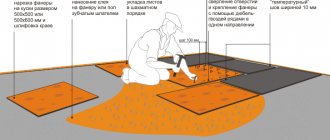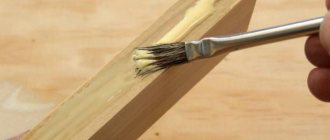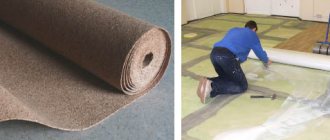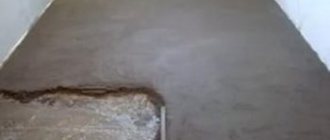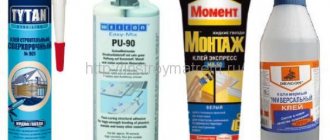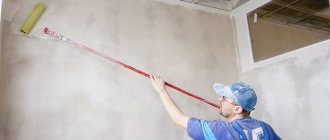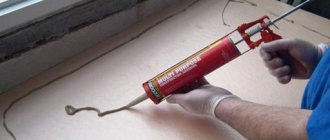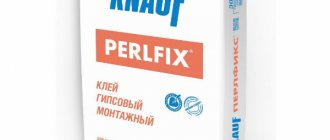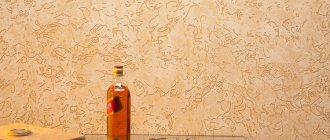One of the most popular materials for flooring is linoleum, the main advantages of which are: easy installation at home and quick removal, if necessary. This coating is easy to clean and retains its good appearance for a long time.
Before gluing linoleum to concrete, you need to properly prepare the base. It is very important that it is sufficiently smooth and clean. Any, even the smallest, irregularities will lead to rapid wear of the linoleum. If there is significant damage to the floor, it makes sense to update the screed. Both conventional pours (cement or concrete) and modern self-leveling mixtures are suitable for this, the advantages of which are quick drying and time saving. If this is your first installation experience, then it is better to consult with a specialist, and he will tell you how to glue linoleum.
How to lay a coating on concrete
The room in which the coating will be glued to the concrete floor must be warm and dry, the quality of the flooring depends on this. Before gluing the linoleum, you need to spread it on the floor and let it rest for a while so that it levels out. Then you will need to cut the material, taking into account the combination of the pattern and the placement of the canvases in the room. When cutting, you need to leave a margin of at least 10 centimeters on each side.
If during gluing a seam is formed between the canvases, you can try to make it less noticeable. To do this, the seam must be positioned in the direction of light from the windows.
Glue installation technology
We figured out what glue to use to glue linoleum to concrete, now let's briefly look at the gluing process itself. I would like to immediately draw your attention to the fact that it is advisable to apply glue not only to the floor, but also to the linoleum itself. The first step is to cut the original roll of material and adjust it to the size of the room. It is recommended to do this after the linoleum has been in the room for some time and has settled to a given area. If the floor area is blocked by various obstacles (pipes, niches for batteries, etc.), it is recommended to immediately cut and fit everything.
Important! It is not recommended to cut off large pieces initially. It is better to initially cut off several short pieces, because in the future, if a cut becomes necessary, there will be another seam, and at its joining you will again lose a certain amount of material.
Do the same with the other half.
Next, fold back half of the spread material and coat the floor with glue, using a roller or spatula. Lay the folded edge and smooth it carefully with a brush or something suitable. A similar operation must be performed on the other edge. It is especially recommended to apply glue to the joints and on the threshold at the entrance to the room. At the joints, the material should be bent a little and a little more glue or mastic should be applied with passion.
Styling tools
In order to properly glue linoleum you will need the following tools:
- Sharp stationery knife;
- Roller;
- Large ruler;
- Two brushes;
- Adhesive material (mastic, double-sided tape or special glue).
There are two options for gluing the canvas to the concrete floor:
- Gluing with tape . This method is very simple and can be easily done at home, but the coating wears out quickly after such installation.
- Gluing using special mastics or glue . This method of gluing linoleum is more labor-intensive, however, very effective.
Mastics have high strength and are resistant to moisture, which makes them a good waterproofing agent. Based on the technical characteristics of the coating, different types of adhesives are used.
- For fabric-based canvas, dispersion glue or bituminous synthetic adhesive mastic is suitable.
- For coatings that do not have a base, synthetic mastics made using rubber and various resins are suitable.
- Linoleum with a heat-insulating base can be sealed using dispersion glue.
You can use a self-made adhesive base, however, the reliability of gluing in this case is questionable.
A special adhesive for attaching the canvas to a concrete floor has good elasticity and will not peel off under high loads. There are two main types of gluing linoleum:
- Fixation, for which a composition with moderate adhesive ability is used. This method is best used in small rooms with little load.
- Continuous gluing is carried out using one of the following adhesive mixtures: Eco-friendly water-dispersion glue;
- Two- or one-component adhesive composition;
- One-component or two-component adhesive;
- Adhesive mixture with solvent;
Rules for dismantling old linoleum
Laying conductive linoleum in tiles.
Speaking about the rules for removing linoleum, first of all it should be noted that its dismantling should be done only in case of emergency, if no other methods can solve your problem.
- When working, it is very good to use a vacuum cleaner with high-quality filters and a special metal attachment. Never replace a vacuum cleaner with a broom or brush.
- Another important point: dismantling of rolled floor coverings is carried out only with the help of a detergent; dry removal is not allowed. The felt base is also removed using a detergent solution.
- All debris generated after removing the linoleum must be packed in good quality (dense) bags, the thickness of which is 6 mm or more. Construction waste of this nature is transported exclusively to those landfills where it is permitted to dispose of this waste.
How to replace dismantling linoleum?
Floor construction.
As noted above, dismantling work with old linoleum is carried out only in cases of extreme necessity. If there is no such need, then you can use the following options:
- lay a new layer of the selected floor covering on top of the old linoleum;
- leveling the surface of the old coating using a special composition intended specifically for these purposes;
- professionally prepare the surface covered with the old layer of linoleum before laying a new floor covering.
Having chosen a new flooring option, you need to read the installation instructions, which will most likely describe in detail the process of preparing the surface for installation.
How to glue linoleum?
To properly seal the linoleum flooring with double-sided tape, the adhesive tape must first be applied to the concrete floor, leaving a protective film. Then you need to spread the linoleum on top, bend one half of the canvas, remove the protective film from the adhesive tape and spread the linoleum again. Then the canvas should be ironed well and you can begin gluing the second half.
To lay the sheet on glue, you need to bend half of the sheet and coat the floor with glue using a spatula or roller. After this, the coating must be spread and carefully leveled. The same procedure must be done on the other side.
If you need to glue strips of linoleum end-to-end, then you first need to overlap them, then bend the edges of the canvas and apply glue to them. At the place of application, using a sharp knife, it is necessary to cut through both layers of the canvas, remove the scraps and seal the edges. By carrying out this procedure, you can get perfectly glued edges of the fabric together, which will merge into an imperceptible seam.
What to glue linoleum to - choosing glue and working with it
When choosing adhesive for linoleum, you need to consider the following points:
- type of floor covering (for example, different adhesives are required for laying PVC-based linoleum and linoleum with natural components),
- processing area (it can be continuous and local),
- the “lifetime” of linoleum (whether it was glued a long time ago or is just about to be laid).
Let's look at the most popular adhesives.
Dispersion adhesives
They are a solution of cellulose-glycolic acid and acrylic with aqueous suspensions. The best option for continuous gluing of linoleum on a fabric, foam and felt base. Dispersion glue is elastic, non-toxic, and provides high-quality fixation. Among the disadvantages, it is worth noting poor resistance to low temperatures, moisture and transportation.
The following subspecies can be distinguished in this category:
1.Acrylate adhesives. Recommended for laying flooring in high-traffic areas, such as offices and shops.
Among the acrylate adhesives that deserve attention:
- PVA - Construction. It is characterized by high adhesive ability and fast setting time. Fireproof, non-toxic. The average cost for 1 kg is 45 rubles. Consumption per 1 sq. m. - about 500-700 g.
- Polynomial No. 101. Suitable for all types of linoleum, as well as carpet and heavy types of wall coverings. It has high adhesion to various materials, is frost-resistant, and does not have an unpleasant odor. The average price for 1 kg is 60-80 rubles. Composition consumption per 1 sq. m. - about 300-400 g.
- Homakoll 208. Good adhesive for household linoleum on a pile, foam and woven basis, as well as decorative panels and polystyrene foam tiles. Easy to apply, does not shrink, is explosion and fireproof. The cost of 1 kg of glue is about 200 rubles. For 1 sq. m. surface will require 300-500 g of glue.
2.Bustilat. Suitable for gluing linoleum on a felt basis. It has no unpleasant odor, is environmentally friendly, and is frost-resistant. It is characterized by high peel strength, drying time is about a day. Glue consumption in one layer is 80-255 g per 1 sq. m. Price 1 kg – about 150 rubles.
3.Gumilax. This is the most suitable composition for gluing linoleum made from natural materials; it can also be used for linoleum with a fabric or felt primary layer. Made from rubber and latex. Glue consumption per 1 sq. m. is about 700-800 g. The average price for 1 kg of composition is 120-150 rubles.
4. Bitumen mastic. It is a black bitumen-polymer composition. Can be used for installing fabric-based linoleum in non-residential premises with high humidity - swimming pools, laundries, baths. Price for 1 kg is about 30 rubles. Consumption of bitumen mastic per 1 sq. m. when applying a layer of 2 mm - about 1 kg.
Reaction adhesives
Such adhesives are a complex mixture of epoxy resin and polyurethane. The composition, reacting with the floor covering, firmly glues it to the base. This creates a durable, water-resistant intermediate layer.
This glue works well when working with fabric-based linoleum, as well as when laying commercial linoleum in industrial premises. Among the disadvantages, it is worth noting the strong odor, fire hazard and higher price compared to dispersion adhesives.
Cold welding adhesives are divided into three groups:
1. Cold welding type A is the most liquid adhesive in consistency; it glues strips of hard commercial and household linoleum well at the joints. Provides an invisible transparent seam.
2. Cold welding type C is a thick glue, optimal when working with linoleum that is no longer new. Used to eliminate joints and cracks 0.3-4 mm wide. Due to its thickness, the glue reliably connects the separated edges of the canvases, forming a wide, thick seam.
3. Cold welding type T - such adhesives are used for gluing joints in polyester-based PVC linoleum.
Among the most well-known cold welding adhesives, it is worth recommending the following compositions:
- Linokol is a French-made glue. Colorless, polymerization time about 6 hours. Consumption of the composition is 50 ml for 15-20 length of seams with a coating thickness of 3 mm. The cost of a 50 ml package is about 250 rubles.
- Homakoll S 401 is a Russian adhesive that forms a durable waterproof layer. Reliably joins PVC-based floor coverings. Glue consumption - 60 ml per 24-30 m/p seam (with a linoleum thickness of 3 mm). The price of a 60 ml package is about 275 rubles.
- FORBO Eurocol 671 is a cold welding adhesive for laying heterogeneous and homogeneous PVC-based commercial linoleum. Provides a strong and tight connection. Hardening time is about 60 minutes. The cost of a 42 g package is about 370 rubles. Glue consumption – 42 g/25 m2.
As an alternative to glue, you can consider tape. They are used when the use of mastic and glue is undesirable. Manufacturers offer paper and fabric based adhesive tapes.
The former are too weak and are not suitable for linoleum, while the latter can retain decorative coatings for 2-4 years. During this time, the linoleum can lie down, and the need for fixation often disappears altogether. However, it is worth keeping in mind that the tape may not hold PVC sheets in place due to changes in temperature and humidity.
The procedure for laying linoleum using the cold welding method:
- stick double-sided tape to the base of the laminate along the entire length of the seam,
- lay the covering on the base, glue it to the floor,
- glue masking tape (adhesive tape) to the joint between the floor covering, and also cut it strictly along the seam,
- squeeze the glue from the tube into the groove, distribute the glue along the entire length.
- After the glue has dried, all that remains is to remove the masking tape and remove the excess hardened glue with a knife.
Cold welding is suitable for working with household and semi-commercial linoleum.
Hot welding
Joints obtained using this method are stronger and more durable compared to cold welding, but the work is much more difficult to perform.
You need an industrial hair dryer with attachments, a knife for cutting linoleum and a special polymer cord.
Hot welding is performed after all work on gluing the linoleum to the floor has been completed.
Operating procedure:
- cut through the covering seam to its full depth using a knife,
- clean the edges of the canvas well,
- turn on an industrial hair dryer at 350C,
- Insert a piece of cord into the nozzle, press the nozzle over the seam, and after a few seconds begin moving the hair dryer along the entire length of the seam.
- It is important to move the hair dryer evenly and smoothly so that the cord melts evenly and fills the groove. If necessary, you can increase the temperature or reduce the speed of the hair dryer.
- After completing the procedure, the excess cord will remain to be cut off with a sickle-shaped knife.
The hot welding method is used in rooms with high traffic and load on commercial and semi-commercial linoleum. The resulting connection is highly reliable and durable.
How to glue linoleum to concrete
VIDEO Before starting work on covering a concrete floor, it is necessary to calculate the exact amount of material that will be required to treat the entire surface. To do this, it is enough to add 10 cm on each side to the total area of the room for a margin.
Then you can begin the first stage of work - preparing the concrete base for laying. Here you will need to perform the following steps:
- Thoroughly clean the floors from dust, dirt and debris,
- Degrease the surface
- In case of minor external defects of the concrete floor, it is enough to treat the surface with putty or primer,
- If, when measuring the differences in the heights of the base, it turns out that they are more than 2 cm, you will have to pour a new concrete screed, which must be carefully leveled and left for several weeks for final drying.
We cut off the excess and iron the linoleum.
After completing the preparatory work, you can begin laying the floor covering.
To do this you will need:
- high-quality glue for linoleum,
- construction knife,
- spatula and roller.
To achieve the expected effect, the following conditions must be observed when performing finishing work:
- The air temperature in the room where the flooring will be laid must not be lower than 18 degrees, and the air humidity should not exceed 68%
- If a material with a pattern is selected, then cutting and laying should be carried out taking into account the need to combine the pattern
- If it is not possible to avoid joining seams, then it is better to place them in the direction of daylight entering the room from the windows
- When choosing an adhesive, you need to consult with a salesperson at a hardware store, who will suggest the optimal solution for a specific brand and type.
At first glance, laying this floor covering with glue may seem somewhat labor-intensive, but in practice, all work on gluing linoleum is carried out quite quickly. To securely fix the coating to the base, you must:
- First spread the linoleum on the floor so that it straightens out. Align the edges of the panels to create a pattern
- Bend the edge of the strip, carefully apply the adhesive composition to the floor underneath, which is leveled using a spatula, lower the floor covering and press firmly to the floor
- These steps are repeated with each strip of linoleum, and after all the elements of the flooring have been glued, they must be allowed to dry. It usually takes several days for the glue to dry completely.
Apply glue and glue linoleum
How to glue linoleum joints
For a more aesthetic and attractive appearance of the floor covering, it is necessary to disguise its joining seams as much as possible.
For linoleum, special adhesive compositions are most often used, which are also called cold welding, and differ significantly from conventional glue, which is used to fix the material on a concrete or wooden base.
VIDEO INSTRUCTIONS For the most aesthetic and attractive appearance of joining seams, you can use bustilate glue for linoleum, which has such properties as transparency, fluidity and strong fixation of joints.
When processing seams with bustylate glue, you don’t have to worry about the appearance of your floor covering, since this adhesive composition is practically invisible even on light-colored material.
Author of the article - Kristina Sekushina
kakkley.ru
How to seal holes in the coating?
Sometimes, due to mechanical damage to the linoleum, holes may appear on it. However, torn linoleum is not a reason for frustration. You can seal the hole with or without a patch.
If the fabric is simply torn or the seam at the junction is damaged, then you can use special glue. To do this, you need to smooth out the damaged fragment, lubricate it well with adhesive and place it under a press.
If you still need to apply a patch, then you need to select a fragment of canvas that would completely cover the hole in size. Then you need to glue the patch onto the damaged area and, using a sharp knife, carefully cut through both layers of linoleum. After the procedure is completed, heavy oppression must be placed on the area.
